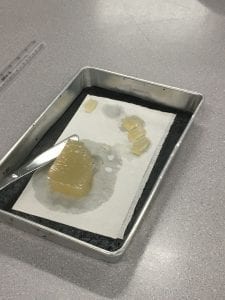Purpose: To determine if size effects diffusion and which size is most effective.
Hypothesis: The smallest cube will diffuse best, allowing the NaOH to travel through the Agar and react with the phenolphthalein in the mixture.




Questions:
In terms of maximizing diffusion, what was the most effective size cube that you tested?
The smallest cube () was most effective in maximizing diffusion; it had a higher percent of it being diffused than the medium sized and large cube.
Why was that size most effective at maximizing diffusion? What are the important factors that affect how materials diffuse into cells or tissues?
The cube was most effective in diffusion because it has a higher surface area to volume ratio compared to the larger cubes. Factors that can affect how materials diffuse into cells/tissues are how large the cell is, the concentration of the substance being diffused, temperature of the system, and the type of material that has substances diffusing among it.
If a large surface area is helpful to cells, why do cells not grow to be very large?
Cells do not grow to be very large because although a large surface area can be helpful, having a larger size makes it less efficient to diffuse substances as larger cell will have a higher surface area to volume ratio.
You have three cubes, A, B, and C. they have surface to volume ratios of 3:1, 5:2, and 4:1 respectively. Which of these cubes is going to be the most effective at maximizing diffusion how do you know this?
The cube that is going to be most effective at maximizing diffusing is the one that has the highest surface are to volume ratio: 4:1. The cell which has this ratio is most likely the cube: which our results confirm this was best at diffusing the NaOH.
How does your body adapt surface area-to-volume ratios to help exchange gasses?
Our body adapts to exchange gases by creating more cell cells, which creates more surface area and increases the body’s surface area to volume ratio.
Why can’t certain cells, like bacteria, get to be the size of a small fish?
Bacteria are unicellular organisms. The reason why they are small is because of this surface area to volume ratio, where it would make diffusion less efficient if the cell was large. Therefor, to maintain this stable ratio, Bacteria divides into equal sizes.
What are the advantages of large organisms being multicellular?
The advantages of large organisms being multicellular is: being composed of many cells allows animals (including us) to be more complex and allow us to perform more unique actions/functions. Having more cells also allows our body to perform more functions as there is more of an opportunity to have more unique type cells.
